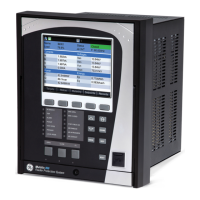CHAPTER 6: PROTECTION SETPOINTS CURRENT ELEMENTS
850 FEEDER PROTECTION SYSTEM – INSTRUCTION MANUAL 6–79
Thermal Overload (49)
The thermal overload protection (Thermal Model) can be applied to prevent damage to the
protected cables, dry transformers, capacitor banks, or even overhead lines. Loads
exceeding the load ratings of the protected equipment can, over time, degrade the
insulation, and may, in return, lead to short circuit conditions. As the heating of plant
equipment such as cables or transformers is resistive (I
2
R), the generated heat is directly
proportional to the square of the flowing current (I
2
). The relay uses a thermal time
characteristic based on current squared and integrated over time.
The relay will continuously calculate the thermal capacity as a percentage of the total
thermal capacity. The thermal capacity is calculated as follows:
Where:
θ (t) = Cable thermal capacity (%) at time t
θ (t-1) = Cable thermal capacity (%) at time t-1
∆t/τ = Time step ∆t divided by the heating or cooling time constant τ
τ = Heating and cooling time constant, usually provided by the manufacturer
I
phase/Ipickup
= Ratio between the actual load current and the pickup setting.
The heating time constant is used when the squared load/Pickup ratio is greater than the
thermal capacity θ(t-1) estimated in the previous time step. Otherwise the formula uses the
cooling time constant.
When the load current exceeds the PKP setting, and the element picks up. At the same time
the thermal capacity will start to increase at a rate depending on the current amplitude,
the prior loading condition of the cable and heating time constant. When the thermal
capacity exceeds the alarm level, the element will generate an alarm signal that may turn
on a programmable LED. The thermal model alarm can be used as a warning for the start
of dangerous overloading conditions, and can prevent unnecessary tripping. When the
thermal capacity exceeds the Trip level (i.e., higher than 100% thermal capacity), the
element will generate a Trip signal. The Trip flag will drop out when the Thermal capacity
falls below 97%.
Path: Setpoints > Protection > Group 1(6) > Current > Thermal Overload 1(X)
FUNCTION
Range: Disabled, Trip, Alarm, Latched Alarm, Configurable
Default: Disabled
This class of setpoint is described in the Common Setpoints section located at the
beginning of the Setpoints chapter.
SIGNAL INPUT
Range: dependant upon the order code
Default: CT Bank 1 –J1
This setting provides selection for the current bank input.
PICKUP
Range: 0.050 to 30.000 x CT in steps of 0.001 x CT
Default: 1.000 x CT
This setting sets the Pickup level of the phase current.

